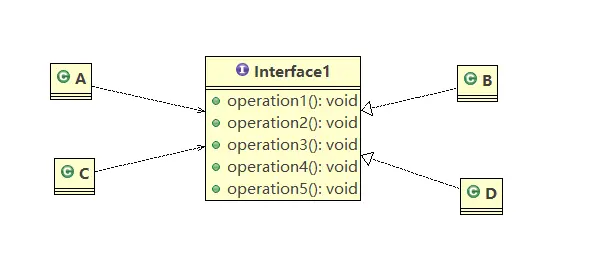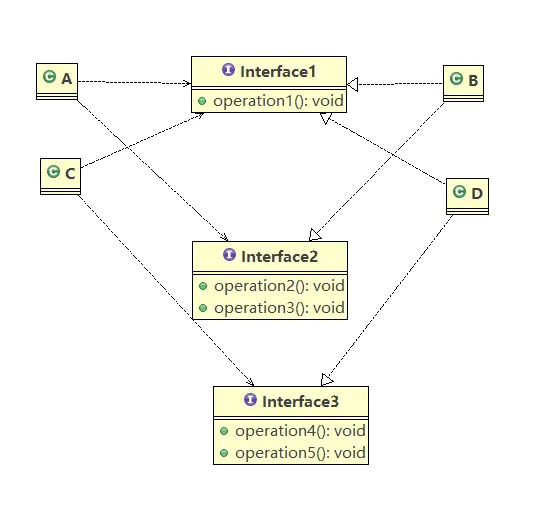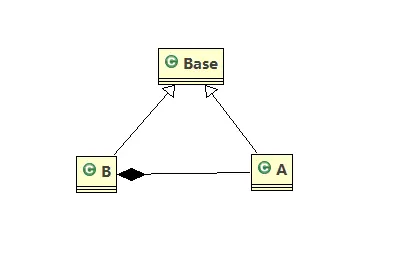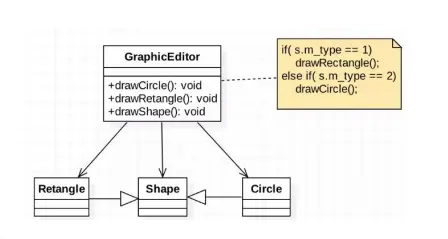 设计模式原则
设计模式原则
欢迎来到我的 ChatGPT 中转站,极具性价比,为付费不方便的朋友提供便利,有需求的可以添加左侧 QQ 二维码,另外,邀请新用户能获取余额哦!最后说一句,那啥:请自觉遵守《生成式人工智能服务管理暂行办法》。
设计模式原则,其实就是程序员在编程时,应当遵守的原则,也是各种设计模式的基础 (即:设计模式为什么这样设计的依据)
设计模式常用的七大原则
# 单一职责原则
# 基本介绍
- 降低类的复杂度,一个类只负责一项职责。
- 提高类的可读性,可维护性
- 降低变更引起的风险
- 通常情况下,我们应当遵守单一职责原则,只有逻辑足够简单,才可以在代码级违反单一职责原则
- 只有类中方法数量足够少,可以在方法级别保持单一职责原则
# 代码实例
package principle.singleresponsibility;
/**
* 单一职责原则演示 未遵循单一职责原则,导致轮船和飞机都在公路上运行
*/
public class SingleResponsibility1 {
public static void main(String[] args) {
Vehicle vehicle = new Vehicle();
vehicle.run("自行车");
vehicle.run("轮船");
vehicle.run("飞机");
}
}
// 未遵守单一职责原则的结果
class Vehicle {
public void run(String vehicle) {
System.out.println(vehicle + "在公路上运行");
}
}
1
2
3
4
5
6
7
8
9
10
11
12
13
14
15
16
17
18
19
20
21
2
3
4
5
6
7
8
9
10
11
12
13
14
15
16
17
18
19
20
21
# 改进实例
package principle.singleresponsibility;
/**
* 单一职责原则演示
* 遵循单一职责原则
*/
public class SingleResponsibility2 {
public static void main(String[] args) {
WaterVehicle waterVehicle = new WaterVehicle();
waterVehicle.run("轮船");
AirVehicle airVehicle = new AirVehicle();
airVehicle.run("飞机");
RoadVehicle roadVehicle = new RoadVehicle();
roadVehicle.run("自行车");
}
}
class WaterVehicle {
public void run(String vehicle) {
System.out.println(vehicle + "在水上运行");
}
}
class AirVehicle {
public void run(String vehicle) {
System.out.println(vehicle + "在水上运行");
}
}
class RoadVehicle {
public void run(String vehicle) {
System.out.println(vehicle + "在水上运行");
}
}
1
2
3
4
5
6
7
8
9
10
11
12
13
14
15
16
17
18
19
20
21
22
23
24
25
26
27
28
29
30
31
32
33
34
2
3
4
5
6
7
8
9
10
11
12
13
14
15
16
17
18
19
20
21
22
23
24
25
26
27
28
29
30
31
32
33
34
package principle.singleresponsibility;
/**
* 单一职责原则演示
* 在方法上遵循单一职责原则,只有类中方法数量足够少,可以在方法级别保持单一职责原则
*/
public class SingleResponsibility3 {
public static void main(String[] args) {
Vehicle2 vehicle = new Vehicle2();
vehicle.waterRun("轮船");
vehicle.airRun("飞机");
vehicle.roadRun("自行车");
}
}
class Vehicle2 {
public void waterRun(String vehicle) {
System.out.println(vehicle + "在水上运行");
}
public void roadRun(String vehicle) {
System.out.println(vehicle + "在公路上运行");
}
public void airRun(String vehicle) {
System.out.println(vehicle + "在天空上运行");
}
}
1
2
3
4
5
6
7
8
9
10
11
12
13
14
15
16
17
18
19
20
21
22
23
24
25
26
27
28
2
3
4
5
6
7
8
9
10
11
12
13
14
15
16
17
18
19
20
21
22
23
24
25
26
27
28
# 接口隔离原则
# 基本介绍
客户端应该不依赖于它不需要的接口。一个类对另一个类的依赖应该建立在最小的接口上。在设计接口时,应该尽量地细化,使其成为单一的接口。
# 代码实例

/**
* 这个不满足接口隔离原则,
* 类A通过接口Interface1依赖类B,
* 类C通过接口Interface1依赖类D,
* 如果接口Interface1对于类A和类C来说不是最小接口,
* 那么类B和类D必须去实现他们不需要的方法。
*
*/
public class Segregation1 {
public static void main(String[] args) {
A a = new A();
C c = new C();
a.use(new B());
c.use(new D());
}
}
interface Interface1 {
void operation1();
void operation2();
void operation3();
void operation4();
void operation5();
}
class B implements Interface1 {
@Override
public void operation1() {
System.out.println("类B实现了operation1");
}
@Override
public void operation2() {
System.out.println("类B实现了operation2");
}
@Override
public void operation3() {
System.out.println("类B实现了operation3");
}
@Override
public void operation4() {
System.out.println("类B实现了operation4");
}
@Override
public void operation5() {
System.out.println("类B实现了operation5");
}
}
class D implements Interface1 {
@Override
public void operation1() {
System.out.println("类D实现了operation1");
}
@Override
public void operation2() {
System.out.println("类D实现了operation2");
}
@Override
public void operation3() {
System.out.println("类D实现了operation3");
}
@Override
public void operation4() {
System.out.println("类D实现了operation4");
}
@Override
public void operation5() {
System.out.println("类D实现了operation5");
}
}
class A {
public void use(Interface1 interface1) {
interface1.operation1();
interface1.operation2();
interface1.operation3();
}
}
class C {
public void use(Interface1 interface1) {
interface1.operation1();
interface1.operation4();
interface1.operation5();
}
}
1
2
3
4
5
6
7
8
9
10
11
12
13
14
15
16
17
18
19
20
21
22
23
24
25
26
27
28
29
30
31
32
33
34
35
36
37
38
39
40
41
42
43
44
45
46
47
48
49
50
51
52
53
54
55
56
57
58
59
60
61
62
63
64
65
66
67
68
69
70
71
72
73
74
75
76
77
78
79
80
81
82
83
84
85
86
87
88
89
90
91
92
93
94
95
96
97
98
99
100
101
102
2
3
4
5
6
7
8
9
10
11
12
13
14
15
16
17
18
19
20
21
22
23
24
25
26
27
28
29
30
31
32
33
34
35
36
37
38
39
40
41
42
43
44
45
46
47
48
49
50
51
52
53
54
55
56
57
58
59
60
61
62
63
64
65
66
67
68
69
70
71
72
73
74
75
76
77
78
79
80
81
82
83
84
85
86
87
88
89
90
91
92
93
94
95
96
97
98
99
100
101
102
# 改进实例

package principle.prisegregation;
/**
* 将接口Interface1拆分为独立的几个接口,
* 类A和类C分别与他们需要的接口建立依赖关系。
* 也就是采用接口隔离原则
*/
public class Segregation2 {
public static void main(String[] args) {
A1 a1 = new A1();
C1 c1 = new C1();
a1.use1(new B1());
a1.use2(new B1());
c1.use1(new D1());
c1.use2(new D1());
}
}
interface Interface2 {
void operation1();
}
interface Interface3 {
void operation2();
void operation3();
}
interface Interface4 {
void operation4();
void operation5();
}
class B1 implements Interface2, Interface3 {
@Override
public void operation1() {
System.out.println("类B实现了operation1");
}
@Override
public void operation2() {
System.out.println("类B实现了operation2");
}
@Override
public void operation3() {
System.out.println("类B实现了operation3");
}
}
class D1 implements Interface2, Interface4 {
@Override
public void operation1() {
System.out.println("类D实现了operation1");
}
@Override
public void operation4() {
System.out.println("类D实现了operation4");
}
@Override
public void operation5() {
System.out.println("类D实现了operation5");
}
}
class A1 {
public void use1(Interface2 interface2) {
interface2.operation1();
}
public void use2(Interface3 interface3) {
interface3.operation2();
interface3.operation3();
}
}
class C1 {
public void use1(Interface2 interface2) {
interface2.operation1();
}
public void use2(Interface4 interface4) {
interface4.operation4();
interface4.operation5();
}
}
1
2
3
4
5
6
7
8
9
10
11
12
13
14
15
16
17
18
19
20
21
22
23
24
25
26
27
28
29
30
31
32
33
34
35
36
37
38
39
40
41
42
43
44
45
46
47
48
49
50
51
52
53
54
55
56
57
58
59
60
61
62
63
64
65
66
67
68
69
70
71
72
73
74
75
76
77
78
79
80
81
82
83
84
85
86
87
88
89
90
91
92
93
94
95
96
2
3
4
5
6
7
8
9
10
11
12
13
14
15
16
17
18
19
20
21
22
23
24
25
26
27
28
29
30
31
32
33
34
35
36
37
38
39
40
41
42
43
44
45
46
47
48
49
50
51
52
53
54
55
56
57
58
59
60
61
62
63
64
65
66
67
68
69
70
71
72
73
74
75
76
77
78
79
80
81
82
83
84
85
86
87
88
89
90
91
92
93
94
95
96
# 依赖倒转 (倒置) 原则
# 基本介绍
- 高层模块不应该依赖低层模块,二者都应该依赖其抽象
- 抽象不应该依赖细节,细节应该依赖抽象
- 依赖倒转 (倒置) 的中心思想是面向接口编程
- 依赖倒转原则是基于这样的设计理念:相对于细节的多变性,抽象的东西要稳定的多。以抽象为基础搭建的架构比以细节为基础的架构要稳定的多。在 java 中,抽象指的是接口或抽象类,细节就是具体的实现类
- 使用接口或抽象类的目的是制定好规范,而不涉及任何具体的操作,把展现细节的任务交给他们的实现类去完成
# 代码实例
分析
- 简单,比较容易想到
- 如果我们获取的对象是 微信,短信等等,则新增类,同时 Perons 也要增加相应的接收方法
package principle.inversion;
/**
* 依赖倒转
*/
public class DependecyInversion {
public static void main(String[] args) {
Person person = new Person();
person.receive(new Email());
}
}
class Email {
public String getInfo() {
return "电子邮件信息: hello,world";
}
}
//完成Person接收消息的功能
class Person {
public void receive(Email email) {
System.out.println(email.getInfo());
}
}
1
2
3
4
5
6
7
8
9
10
11
12
13
14
15
16
17
18
19
20
21
22
23
24
25
2
3
4
5
6
7
8
9
10
11
12
13
14
15
16
17
18
19
20
21
22
23
24
25
# 改进实例
解决思路:引入一个抽象的接口 IReceiver, 表示接收者,这样 Person 类与接口 IReceiver 发生依赖,因为 Email, WeiXin 等等属于接收的范围,他们各自实现 IReceiver 接口就 ok, 这样我们就符合依赖倒转原则
package principle.inversion.improve;
public class DependecyInversion {
public static void main(String[] args) {
// 客户端无需改变
Person person = new Person();
person.receive(new Email());
person.receive(new WeChat());
}
}
/**
* 定义接口
*/
interface IReceiver {
String getInfo();
}
class Email implements IReceiver {
@Override
public String getInfo() {
return "电子邮件信息: hello,world";
}
}
class WeChat implements IReceiver {
@Override
public String getInfo() {
return "微信信息: hello,world";
}
}
//方式2
class Person {
// 这里我们是对接口的依赖
public void receive(IReceiver receiver) {
System.out.println(receiver.getInfo());
}
}
1
2
3
4
5
6
7
8
9
10
11
12
13
14
15
16
17
18
19
20
21
22
23
24
25
26
27
28
29
30
31
32
33
34
35
36
37
38
39
40
41
42
43
2
3
4
5
6
7
8
9
10
11
12
13
14
15
16
17
18
19
20
21
22
23
24
25
26
27
28
29
30
31
32
33
34
35
36
37
38
39
40
41
42
43
package principle.inversion.improve;
/**
* 用一个稍微复杂点的案例,打开不同品牌电视的例子,
*/
public class DependencyPass {
public static void main(String[] args) {
OpenAndClose openAndClose = new OpenAndClose();
ITV changHong = new ChangHong();
openAndClose.open(changHong);
}
}
/**
* 电视接口的实现
*/
class ChangHong implements ITV {
@Override
public void play() {
// TODO Auto-generated method stub
System.out.println("长虹电视机,打开");
}
}
//方式1: 通过接口传递实现依赖
//开关的接口
interface IOpenAndClose {
public void open(ITV tv); // 抽象方法,接收接口
}
interface ITV { // ITV接口
public void play();
}
//实现接口
class OpenAndClose implements IOpenAndClose {
public void open(ITV tv) {
tv.play();
}
}
//方式2: 通过构造方法依赖传递
//interface IOpenAndClose {
//public void open(); //抽象方法
//}
//interface ITV { //ITV接口
//public void play();
//}
//class OpenAndClose implements IOpenAndClose{
//public ITV tv; //成员
//public OpenAndClose(ITV tv){ //构造器
//this.tv = tv;
//}
//public void open(){
//this.tv.play();
//}
//}
//方式3 , 通过setter方法传递
//interface IOpenAndClose {
// public void open(); // 抽象方法
//
// public void setTv(ITV tv);
//}
//
//interface ITV { // ITV接口
// public void play();
//}
//
//class OpenAndClose implements IOpenAndClose {
// private ITV tv;
//
// public void setTv(ITV tv) {
// this.tv = tv;
// }
//
// public void open() {
// this.tv.play();
// }
//}
1
2
3
4
5
6
7
8
9
10
11
12
13
14
15
16
17
18
19
20
21
22
23
24
25
26
27
28
29
30
31
32
33
34
35
36
37
38
39
40
41
42
43
44
45
46
47
48
49
50
51
52
53
54
55
56
57
58
59
60
61
62
63
64
65
66
67
68
69
70
71
72
73
74
75
76
77
78
79
80
81
82
83
2
3
4
5
6
7
8
9
10
11
12
13
14
15
16
17
18
19
20
21
22
23
24
25
26
27
28
29
30
31
32
33
34
35
36
37
38
39
40
41
42
43
44
45
46
47
48
49
50
51
52
53
54
55
56
57
58
59
60
61
62
63
64
65
66
67
68
69
70
71
72
73
74
75
76
77
78
79
80
81
82
83
笔记
依赖倒转原则的注意事项和细节
- 低层模块尽量都要有抽象类或接口,或者两者都有,程序稳定性更好
- 变量的声明类型尽量是抽象类或接口,这样我们的变量引用和实际对象间,就存在一个缓冲层,利于程序扩展和优化
- 继承时遵循里氏替换原则
# 里氏替换原则
# 基本介绍
OO(面向对象)中的继承性的思考和说明
- 继承包含这样一层含义:父类中凡是已经实现好的方法,实际上是在设定规范和契约,虽然它不强制要求所有的子类必须遵循这些契约,但是如果子类对这些已经实 现的方法任意修改,就会对整个继承体系造成破坏
- 继承在给程序设计带来便利的同时,也带来了弊端。比如使用继承会给程序带来侵入性,程序的可移植性降低,增加对象间的耦合性,如果一个类被其他的类所继承, 则当这个类需要修改时,必须考虑到所有的子类,并且父类修改后,所有涉及到子 类的功能都有可能产生故障
问题提出:在编程中,如何正确的使用继承?=> 里氏替换原则
- 里氏替换原则 (Liskov Substitution Principle) 在 1988 年,由麻省理工学院的以为姓里的女士提出的
- 如果对每个类型为 T1 的对象 o1,都有类型为 T2 的对象 o2,使得以 T1 定义的所有程序 P 在所有的对象 o1 都代换成 o2 时,程序 P 的行为没有发生变化,那么类型 T2 是类型 T1 的子类型。换句话说,所有引用基类的地方必须能透明地使用其子类的对象
- 在使用继承时,遵循里氏替换原则,在子类中尽量不要重写父类的方法
- 里氏替换原则告诉我们,继承实际上让两个类耦合性增强了,在适当的情况下,可以通过聚合,组合,依赖来解决问题。.
# 代码实例
package principle.liskov;
/**
* 里氏替换原则
*/
public class Liskov {
public static void main(String[] args) {
A a = new A();
System.out.println("11-3=" + a.func1(11, 3));
System.out.println("1-8=" + a.func1(1, 8));
System.out.println("-----------------------");
B b = new B();
System.out.println("11-3=" + b.func1(11, 3));// 这里本意是求出11-3,但是无意重写了父类A的方法,导致结果出问题
System.out.println("1-8=" + b.func1(1, 8));// 1-8
System.out.println("11+3+9=" + b.func2(11, 3));
}
}
/**
* 基类
*/
class A {
// 返回两个数的差
public int func1(int num1, int num2) {
return num1 - num2;
}
}
// B类继承了A
// 增加了一个新功能:完成两个数相加,然后和9求和
class B extends A {
// 这里,重写了A类的方法, 可能是无意识
public int func1(int a, int b) {
return a + b;
}
public int func2(int a, int b) {
return func1(a, b) + 9;
}
}
1
2
3
4
5
6
7
8
9
10
11
12
13
14
15
16
17
18
19
20
21
22
23
24
25
26
27
28
29
30
31
32
33
34
35
36
37
38
39
40
41
42
43
44
2
3
4
5
6
7
8
9
10
11
12
13
14
15
16
17
18
19
20
21
22
23
24
25
26
27
28
29
30
31
32
33
34
35
36
37
38
39
40
41
42
43
44
# 改进实例
解决方法
- 我们发现原来运行正常的相减功能发生了错误。原因就是类 B 无意中重写了父类的方法,造成原有功能出现错误。在实际编程中,我们常常会通过重写父类的方法完成新的功能,这样写起来虽然简单,但整个继承体系的复用性会比较差。特别是运行多态比较频繁的时候
- 通用的做法是:原来的父类和子类都继承一个更通俗的基类,原有的继承关系去掉, 采用依赖,聚合,组合等关系代替

package principle.liskov.improve;
/**
* 里氏替换原则
*
*/
public class Liskov {
public static void main(String[] args) {
A a = new A();
System.out.println("11-3=" + a.func1(11, 3));
System.out.println("1-8=" + a.func1(1, 8));
System.out.println("-----------------------");
B b = new B();
// 因为B类不再继承A类,因此调用者,不会再func1是求减法
// 调用完成的功能就会很明确
System.out.println("11+3=" + b.func1(11, 3));// 这里本意是求出11+3
System.out.println("1+8=" + b.func1(1, 8));// 1+8
System.out.println("11+3+9=" + b.func2(11, 3));
// 使用组合仍然可以使用到A类相关方法
System.out.println("11-3=" + b.func3(11, 3));// 这里本意是求出11-3
}
}
/**
* 基类 把更加基础的方法和成员写到Base类
*/
class Base {
}
/**
* 基类
*/
class A extends Base {
// 返回两个数的差
public int func1(int num1, int num2) {
return num1 - num2;
}
}
// B类继承了A
// 增加了一个新功能:完成两个数相加,然后和9求和
class B extends Base {
private A a = new A();
// 这里,重写了A类的方法, 可能是无意识
public int func1(int a, int b) {
return a + b;
}
public int func2(int a, int b) {
return func1(a, b) + 9;
}
public int func3(int a, int b) {
return this.a.func1(a, b);
}
}
1
2
3
4
5
6
7
8
9
10
11
12
13
14
15
16
17
18
19
20
21
22
23
24
25
26
27
28
29
30
31
32
33
34
35
36
37
38
39
40
41
42
43
44
45
46
47
48
49
50
51
52
53
54
55
56
57
58
59
60
61
62
63
2
3
4
5
6
7
8
9
10
11
12
13
14
15
16
17
18
19
20
21
22
23
24
25
26
27
28
29
30
31
32
33
34
35
36
37
38
39
40
41
42
43
44
45
46
47
48
49
50
51
52
53
54
55
56
57
58
59
60
61
62
63
# 开闭原则
# 基本介绍
- 开闭原则(Open Closed Principle)是编程中最基础、最重要的设计原则
- 一个软件实体如类,模块和函数应该对扩展开放 (对提供方),对修改关闭 (对使用 方)。用抽象构建框架,用实现扩展细节
- 当软件需要变化时,尽量通过扩展软件实体的行为来实现变化,而不是通过修改已 有的代码来实现变化
- 编程中遵循其它原则,以及使用设计模式的目的就是遵循开闭原则
# 代码实例

package principle.ocp;
/**
* 违反了开闭原则
* 这种方式优点是比较好理解,简单易操作。
* 缺点是违反了设计模式的ocp原则,即对扩展开放(提供方),对修改关闭(使用方)。即当我们给类增加新功能的时候,尽量不修改代码,或者尽可能少修改代码
*
*/
public class Ocp {
public static void main(String[] args) {
// 使用看看存在的问题
GraphicEditor graphicEditor = new GraphicEditor();
graphicEditor.drawShape(new Rectangle());
graphicEditor.drawShape(new Circle());
// 当添加一个其他的图形的时候,就需要修改下面所有的类
graphicEditor.drawShape(new Triangle());
}
}
//这是一个用于绘图的类 [使用方]
class GraphicEditor {
// 接收Shape对象,然后根据type,来绘制不同的图形
public void drawShape(Shape s) {
if (s.m_type == 1)
drawRectangle(s);
else if (s.m_type == 2)
drawCircle(s);
else if (s.m_type == 3)
drawTriangle(s);
}
// 绘制矩形
public void drawRectangle(Shape r) {
System.out.println(" 绘制矩形 ");
}
// 绘制圆形
public void drawCircle(Shape r) {
System.out.println(" 绘制圆形 ");
}
// 绘制三角形
public void drawTriangle(Shape r) {
System.out.println(" 绘制三角形 ");
}
}
//Shape类,基类
class Shape {
int m_type;
}
class Rectangle extends Shape {
Rectangle() {
super.m_type = 1;
}
}
class Circle extends Shape {
Circle() {
super.m_type = 2;
}
}
//新增画三角形
class Triangle extends Shape {
Triangle() {
super.m_type = 3;
}
}
1
2
3
4
5
6
7
8
9
10
11
12
13
14
15
16
17
18
19
20
21
22
23
24
25
26
27
28
29
30
31
32
33
34
35
36
37
38
39
40
41
42
43
44
45
46
47
48
49
50
51
52
53
54
55
56
57
58
59
60
61
62
63
64
65
66
67
68
69
70
71
72
2
3
4
5
6
7
8
9
10
11
12
13
14
15
16
17
18
19
20
21
22
23
24
25
26
27
28
29
30
31
32
33
34
35
36
37
38
39
40
41
42
43
44
45
46
47
48
49
50
51
52
53
54
55
56
57
58
59
60
61
62
63
64
65
66
67
68
69
70
71
72
# 改进实例
package principle.ocp.improve;
/**
* 开闭原则
*
*/
public class Ocp {
public static void main(String[] args) {
// 使用看看存在的问题
GraphicEditor graphicEditor = new GraphicEditor();
graphicEditor.drawShape(new Rectangle());
graphicEditor.drawShape(new Circle());
graphicEditor.drawShape(new Triangle());
graphicEditor.drawShape(new OtherGraphic());
}
}
// 这是一个用于绘图的类 [使用方]
class GraphicEditor {
// 接收Shape对象,调用draw方法
public void drawShape(Shape s) {
s.draw();
System.out.print(s.m_type);
}
}
/**
* Shape类,提供抽象方法,让其子类实现
*/
abstract class Shape {
int m_type;
public abstract void draw();// 抽象方法
}
class Rectangle extends Shape {
Rectangle() {
super.m_type = 1;
}
@Override
public void draw() {
// TODO Auto-generated method stub
System.out.println(" 绘制矩形 ");
}
}
class Circle extends Shape {
Circle() {
super.m_type = 2;
}
@Override
public void draw() {
// TODO Auto-generated method stub
System.out.println(" 绘制圆形 ");
}
}
//新增画三角形
class Triangle extends Shape {
Triangle() {
super.m_type = 3;
}
@Override
public void draw() {
// TODO Auto-generated method stub
System.out.println(" 绘制三角形 ");
}
}
//新增一个图形
class OtherGraphic extends Shape {
OtherGraphic() {
super.m_type = 4;
}
@Override
public void draw() {
// TODO Auto-generated method stub
System.out.println(" 绘制其它图形 ");
}
}
1
2
3
4
5
6
7
8
9
10
11
12
13
14
15
16
17
18
19
20
21
22
23
24
25
26
27
28
29
30
31
32
33
34
35
36
37
38
39
40
41
42
43
44
45
46
47
48
49
50
51
52
53
54
55
56
57
58
59
60
61
62
63
64
65
66
67
68
69
70
71
72
73
74
75
76
77
78
79
80
81
82
83
84
85
86
2
3
4
5
6
7
8
9
10
11
12
13
14
15
16
17
18
19
20
21
22
23
24
25
26
27
28
29
30
31
32
33
34
35
36
37
38
39
40
41
42
43
44
45
46
47
48
49
50
51
52
53
54
55
56
57
58
59
60
61
62
63
64
65
66
67
68
69
70
71
72
73
74
75
76
77
78
79
80
81
82
83
84
85
86
# 迪米特法则
# 基本介绍
- 一个对象应该对其他对象保持最少的了解
- 类与类关系越密切,耦合度越大
- 迪米特法则 (Demeter Principle) 又叫最少知道原则,即一个类对自己依赖的类知道的越少越好。也就是说,对于被依赖的类不管多么复杂,都尽量将逻辑封装在类的内部。对外除了提供的 public 方法,不对外泄露任何信息
- 迪米特法则还有个更简单的定义:只与直接的朋友通信
- 直接的朋友:每个对象都会与其他对象有耦合关系,只要两个对象之间有耦合关系, 我们就说这两个对象之间是朋友关系。耦合的方式很多,依赖,关联,组合,聚合等。其中,我们称出现成员变量,方法参数,方法返回值中的类为直接的朋友,而出现在局部变量中的类不是直接的朋友。也就是说,陌生的类最好不要以局部变量的形式出现在类的内部。
# 代码实例
package principle.demeter;
import java.util.ArrayList;
import java.util.List;
//客户端
public class Demeter {
public static void main(String[] args) {
// 创建了一个 SchoolManager 对象
SchoolManager schoolManager = new SchoolManager();
// 输出学院的员工id 和 学校总部的员工信息
schoolManager.printAllEmployee(new CollegeManager());
}
}
//学校总部员工类
class Employee {
private String id;
public void setId(String id) {
this.id = id;
}
public String getId() {
return id;
}
}
//学院的员工类
class CollegeEmployee {
private String id;
public void setId(String id) {
this.id = id;
}
public String getId() {
return id;
}
}
//管理学院员工的管理类
class CollegeManager {
// 返回学院的所有员工
public List<CollegeEmployee> getAllEmployee() {
List<CollegeEmployee> list = new ArrayList<CollegeEmployee>();
for (int i = 0; i < 10; i++) { // 这里我们增加了10个员工到 list
CollegeEmployee emp = new CollegeEmployee();
emp.setId("学院员工id= " + i);
list.add(emp);
}
return list;
}
}
//学校管理类
//分析 SchoolManager 类的直接朋友类有哪些 Employee、CollegeManager
//CollegeEmployee 不是 直接朋友 而是一个陌生类,这样违背了 迪米特法则
class SchoolManager {
// 返回学校总部的员工
public List<Employee> getAllEmployee() {
List<Employee> list = new ArrayList<Employee>();
for (int i = 0; i < 5; i++) { // 这里我们增加了5个员工到 list
Employee emp = new Employee();
emp.setId("学校总部员工id= " + i);
list.add(emp);
}
return list;
}
// 该方法完成输出学校总部和学院员工信息(id)
void printAllEmployee(CollegeManager sub) {
// 分析问题
// 1. 这里的 CollegeEmployee 不是 SchoolManager的直接朋友
// 2. CollegeEmployee 是以局部变量方式出现在 SchoolManager
// 3. 违反了 迪米特法则
// 获取到学院员工
List<CollegeEmployee> list1 = sub.getAllEmployee();
System.out.println("------------学院员工------------");
for (CollegeEmployee e : list1) {
System.out.println(e.getId());
}
// 获取到学校总部员工
List<Employee> list2 = this.getAllEmployee();
System.out.println("------------学校总部员工------------");
for (Employee e : list2) {
System.out.println(e.getId());
}
}
}
1
2
3
4
5
6
7
8
9
10
11
12
13
14
15
16
17
18
19
20
21
22
23
24
25
26
27
28
29
30
31
32
33
34
35
36
37
38
39
40
41
42
43
44
45
46
47
48
49
50
51
52
53
54
55
56
57
58
59
60
61
62
63
64
65
66
67
68
69
70
71
72
73
74
75
76
77
78
79
80
81
82
83
84
85
86
87
88
89
90
91
92
93
94
95
96
97
2
3
4
5
6
7
8
9
10
11
12
13
14
15
16
17
18
19
20
21
22
23
24
25
26
27
28
29
30
31
32
33
34
35
36
37
38
39
40
41
42
43
44
45
46
47
48
49
50
51
52
53
54
55
56
57
58
59
60
61
62
63
64
65
66
67
68
69
70
71
72
73
74
75
76
77
78
79
80
81
82
83
84
85
86
87
88
89
90
91
92
93
94
95
96
97
# 改进实例
package principle.demeter.improve;
import java.util.ArrayList;
import java.util.List;
/**
* 就是说让CollegeEmployee不要以局部变量的方式进入到陌生类中,都尽量将逻辑封装在类的内部。对外除了提供的public方法
*/
public class Demeter {
public static void main(String[] args) {
System.out.println("```使用迪米特法则的改进```");
// 创建了一个 SchoolManager 对象
SchoolManager schoolManager = new SchoolManager();
// 输出学院的员工id 和 学校总部的员工信息
schoolManager.printAllEmployee(new CollegeManager());
}
}
//学校总部员工类
class Employee {
private String id;
public void setId(String id) {
this.id = id;
}
public String getId() {
return id;
}
}
//学院的员工类
class CollegeEmployee {
private String id;
public void setId(String id) {
this.id = id;
}
public String getId() {
return id;
}
}
//管理学院员工的管理类
class CollegeManager {
// 返回学院的所有员工
public List<CollegeEmployee> getAllEmployee() {
List<CollegeEmployee> list = new ArrayList<CollegeEmployee>();
for (int i = 0; i < 10; i++) { // 这里我们增加了10个员工到 list
CollegeEmployee emp = new CollegeEmployee();
emp.setId("学院员工id= " + i);
list.add(emp);
}
return list;
}
// 输出学院员工的信息
public void printEmployee() {
// 获取到学院员工
List<CollegeEmployee> list1 = getAllEmployee();
System.out.println("------------学院员工------------");
for (CollegeEmployee e : list1) {
System.out.println(e.getId());
}
}
}
//学校管理类
class SchoolManager {
// 返回学校总部的员工
public List<Employee> getAllEmployee() {
List<Employee> list = new ArrayList<Employee>();
for (int i = 0; i < 5; i++) { // 这里我们增加了5个员工到 list
Employee emp = new Employee();
emp.setId("学校总部员工id= " + i);
list.add(emp);
}
return list;
}
// 该方法完成输出学校总部和学院员工信息(id)
void printAllEmployee(CollegeManager sub) {
// 分析问题
// 1. 将输出学院的员工方法,封装到CollegeManager
sub.printEmployee();
// 获取到学校总部员工
List<Employee> list2 = this.getAllEmployee();
System.out.println("------------学校总部员工------------");
for (Employee e : list2) {
System.out.println(e.getId());
}
}
}
1
2
3
4
5
6
7
8
9
10
11
12
13
14
15
16
17
18
19
20
21
22
23
24
25
26
27
28
29
30
31
32
33
34
35
36
37
38
39
40
41
42
43
44
45
46
47
48
49
50
51
52
53
54
55
56
57
58
59
60
61
62
63
64
65
66
67
68
69
70
71
72
73
74
75
76
77
78
79
80
81
82
83
84
85
86
87
88
89
90
91
92
93
94
95
96
97
98
99
100
2
3
4
5
6
7
8
9
10
11
12
13
14
15
16
17
18
19
20
21
22
23
24
25
26
27
28
29
30
31
32
33
34
35
36
37
38
39
40
41
42
43
44
45
46
47
48
49
50
51
52
53
54
55
56
57
58
59
60
61
62
63
64
65
66
67
68
69
70
71
72
73
74
75
76
77
78
79
80
81
82
83
84
85
86
87
88
89
90
91
92
93
94
95
96
97
98
99
100
注意
- 迪米特法则的核心是降低类之间的耦合
- 但是由于每个类都减少了不必要的依赖,因此迪米特法则只是要求降低类间 (对象间) 耦合关系,并不是要求完全没有依赖关系
# 合成复用原则
# 基本介绍
- 找出应用中可能需要变化之处,把它们独立出来,不要和那些不需要变化的代码混在一起
- 针对接口编程,而不是针对实现编程
- 为了交互对象之间的松耦合设计而努力

上次更新: 2025/09/02, 06:01:00
